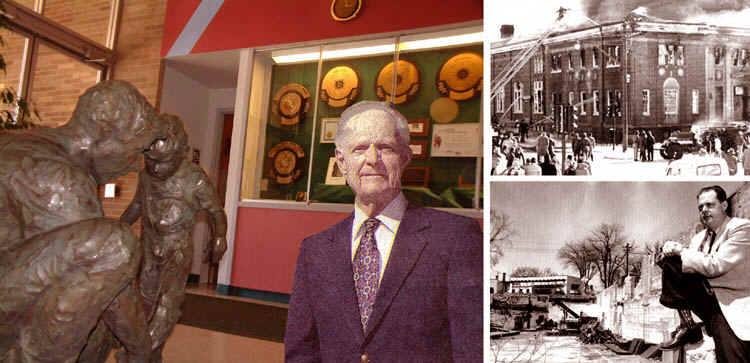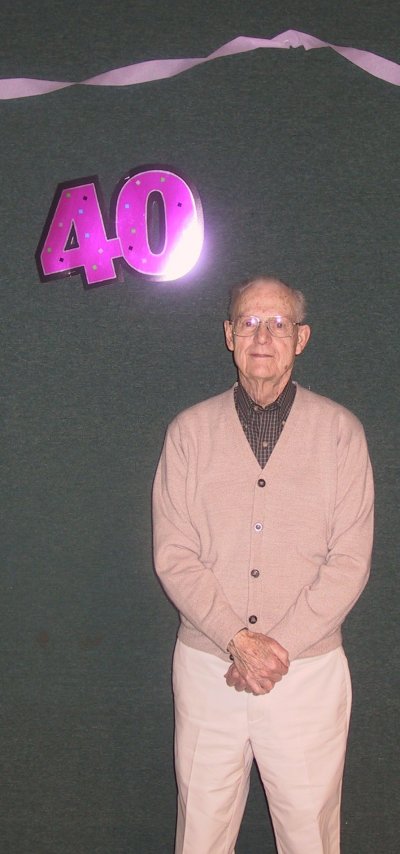
| JOHNSON COUNTY IAGenWeb Project |
Copyright 2004
By Bob Hibbs

Namesake
Robert A. Lee anchors an illustration based on an image of a statue in Iowa
City’s downtown
recreation center lobby, another of fire destroying the predecessor American
Legion Community Building in 1955,
and of a 49-year younger Lee posing in the basement after the fire.
|
By
Bob Hibbs And,
86-year-old Bob Lee whose name the building now carries witnessed it all. Fire actually struck the earlier edifice twice – in 1936 and 1955. It had sat on the College-Gilbert streets corner now occupied by the 1964 Rec Center. The
earlier structure had been built as an auspicious red-brick American Legion
building. A city-sponsored recreation program was begun in its gymnasium in
October 1932, on Wednesday evenings and Saturday mornings. It
augmented sparse local recreation fare during Great Depression years. Summer
offerings included a privately-owned swimming facility in City Park called
“The Big Dipper.” In a 1967 recollection, Earl Sangster described it as “a
cesspool and no larger than the living room of my home.” Others
termed the 1930s facility “small and unattractive,” particularly compared to
a much larger facility in North Liberty. The observations were recorded by
University of Iowa student Donald Rith in his 1967 doctorial thesis. When
fire extensively damaged the Legion’s building July 28, 1936, at the depth of
the depression, repairs were too large a burden for the organization. By
agreement and with voters approving a $35,000 bond issue to finance
reconstruction, the city assumed permanent responsibility for the facility.
In
rebuild form it became the Iowa City Community Building, serving as the local
recreation center, offering such popular programs as Paper Doll teen dances. It
was the teen place to go, recalls 1946 University High School graduate Norma
Mathes Wells. Dances offered an opportunity that “you might meet someone, and
hope to be asked to dance,” she says, adding quickly: “back then girls
didn’t ask boys to dance.” Afterward,
“We might go to Ford Hopkins for a nickel coke,” she reminisces, or to
Whetstones. Both drug stores housed heralded soda fountains of that era a half
century ago. Never mind The Huddle café in the Jefferson Hotel, she says, it
would have been “too expensive for high school kids.” Asked
if the dances offered a chance to flirt, Wells said: “Many probably flirted
with the boys, hoping to be asked to dance; but, of course, I never did,” she
says with a hearty laugh. Within a decade, the popular youth hangout would be
razed by fire – on Jan. 28, 1955. The
1940s also brought a replacement for the abandoned Big Dipper. City
Park pool bonds of $62,500 were approved by voters in September 1941 at the dawn
of World War II by a wide margin, 1,329 to 581. But, the war intervened, and
when efforts were revived after the war, costs had more than doubled, totaling
more than $136,000 when the pool was opened in 1949. Lee
came onto the scene in March 1951, and would oversee the local rec program
during the subsequent 32 years, retiring in 1983. After
the 1955 fire, Lee set about developing community support for a replacement. It
took the better part of a decade, but recreation center bonds of $490,000 were
approved by voters in December 1962 by an overwhelming margin of 2,439 to 355.
The two-level structure cost about $715,000 by its dedication in October 1964. On
his retirement, Lee’s name was attached to the center he was instrumental in
selling to voters, and in running during the ensuing 20 years. “In
my wildest dreams,” Lee has been quoted as saying of displaying his name on
the building, “I never thought it would happen. It made me overjoyed.” Honoring
noble long-time public servants by whatever means always seems like a good idea. Next
Saturday:
Exploring a 1904 City Directory Bob Hibbs collects local postcards and other historic
ephemera and researches history related to them.
|
Addendum by Webmaster

Architects
for the Robert A. Lee Community Recreation Center were Roland C. Wehner and Harvey W.
Henry of Iowa City
dba Wehner and Henry, Architects.
The builder was
Viggo M. Jensen Construction Company of Iowa City
 Bob Lee at the 40th anniversary celebration |
Roland Wehner, Bob Lee, and Harvey Henry 09 Oct 2004 |
|
ROBERT
A. LEE graduated from Coe College in Cedar Rapids with degrees in
He
retired in 1983 after 32 years of service to the community. |